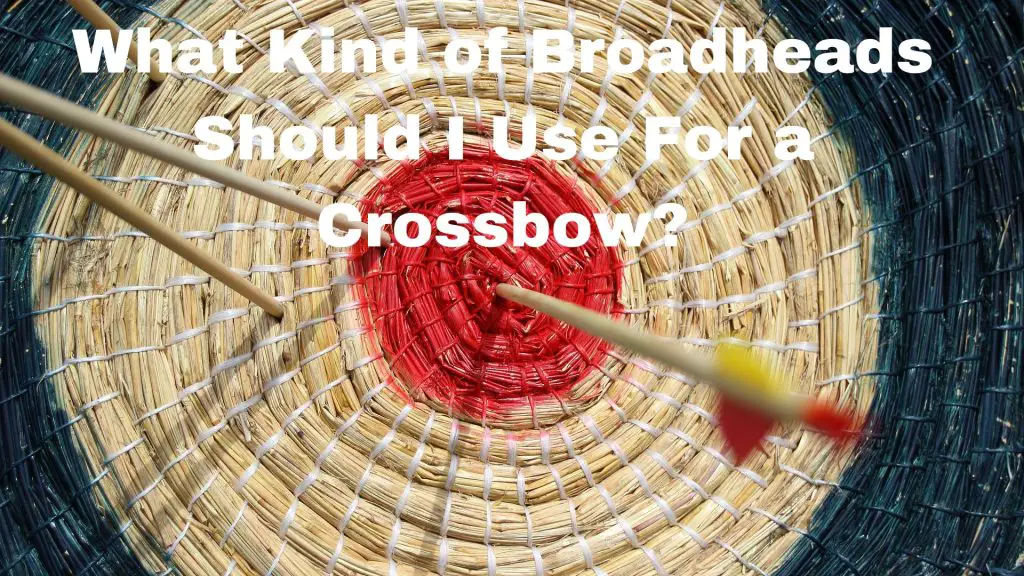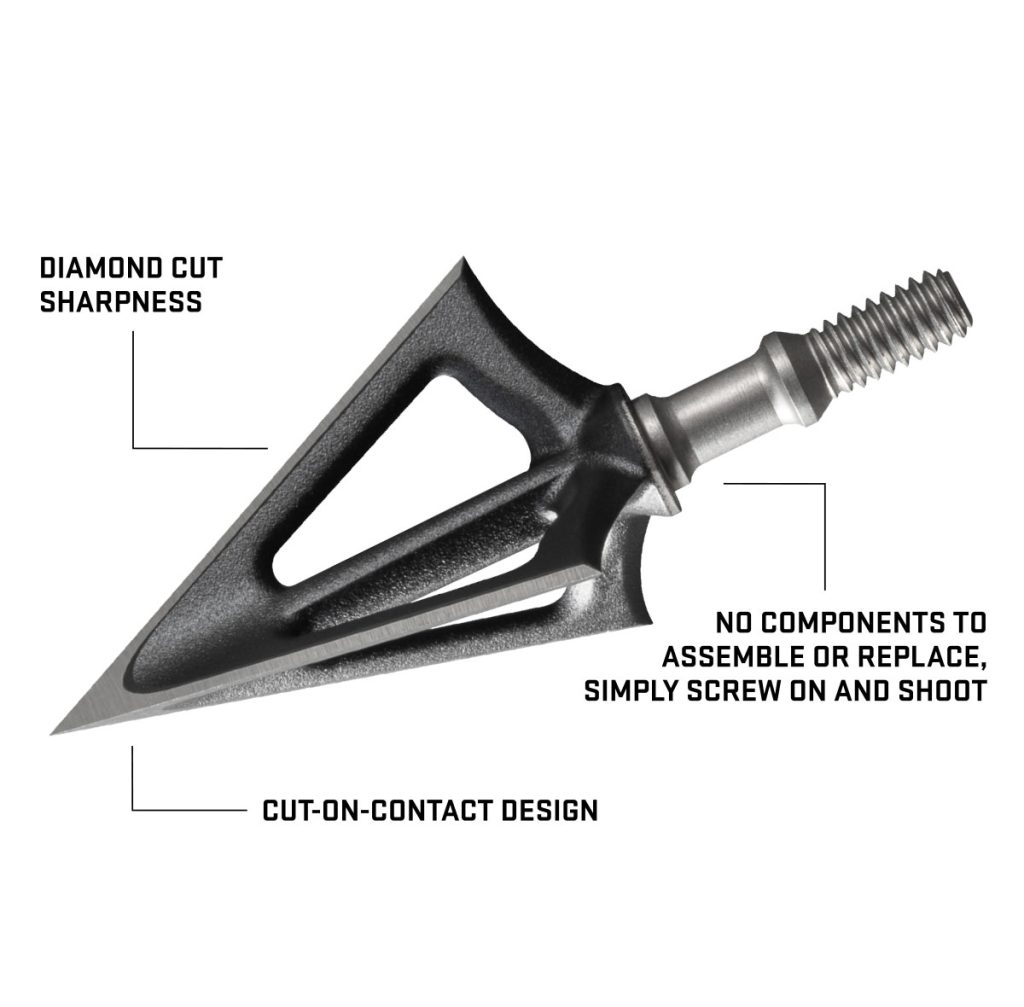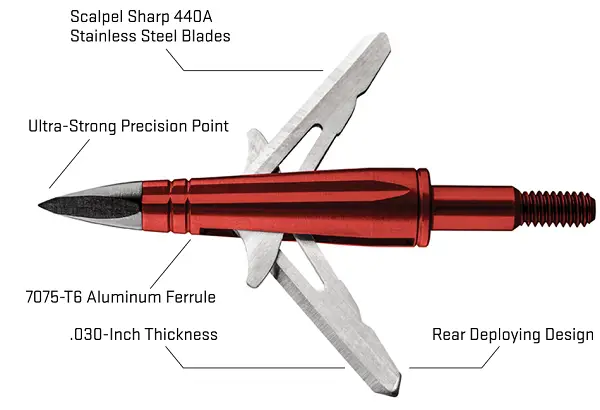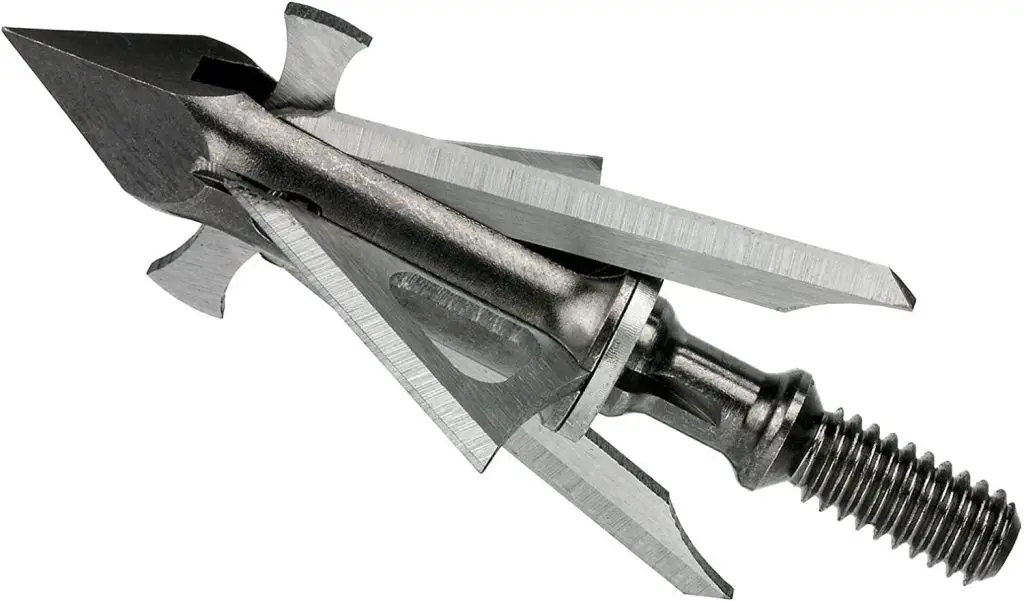What Kind of Broadheads Should I Use For a Crossbow?

Are you ready to start an argument?
Because if you ask a group of passionate crossbow hunters, “Which type of broadheads is superior, mechanical or fixed-blade?” you’re sure to get a heated discussion going.
But why stop there? If you really want to stoke the flames of that argument, you can go one step further and claim that a particular model of broadhead within that type is the best of the best.
So, let’s not beat around the bush. It’s time to take sides and defend our favorite broadheads.
Whether you’re a diehard fan of mechanical broadheads, or you swear by fixed-blade models, there’s no denying that this is a debate worth having.
So let’s roll up our sleeves, get our crossbows ready, and dive into the age-old argument of mechanical vs. fixed-blade broadheads.
Are you ready to join the fray?
In this article, we will take a closer look at the different types of broadheads available for crossbows, including fixed blade, mechanical, and hybrid broadheads.
We will discuss the advantages and disadvantages of each type, as well as the factors to consider when choosing the right kind of broadhead for your crossbow.
We will also cover some tips for maintaining and replacing your broadheads.
By the end of this article, you should have a better understanding of what kind of broadheads you should use for your crossbow and why.
Types Of Broadheads
Fixed Blade Broadheads

Fixed-blade broadheads are one of the most common types of broadheads used for crossbow hunting.
As the name suggests, fixed-blade broadheads have a fixed blade that extends from the tip of the arrow. The blade remains in a fixed position, which means that it does not move or expand upon impact.
Advantages
One of the biggest advantages of using fixed-blade broadheads is their simplicity.
Because they have a fixed design, there are fewer mechanical parts that can potentially fail or malfunction. This makes fixed-blade broadheads more reliable and less prone to failure.
Another advantage of fixed blade broadheads is their durability. Since they do not have any moving parts, fixed blade broadheads are less likely to break or become damaged during use.
Disadvantages
However, there are also some disadvantages to using fixed-blade broadheads.
One of the main drawbacks is their accuracy. Fixed blade broadheads can be more difficult to tune to the crossbow, and they are more susceptible to being affected by wind and other external factors.
Additionally, fixed-blade broadheads can be less forgiving if the shot placement is not perfect, and they may not penetrate as deeply as other types of broadheads.
When To Choose
When choosing fixed-blade broadheads for a crossbow, it is important to consider the weight and the length of the arrow.
The length of the arrow should be matched to the draw length, and the weight of the arrow should be matched to the draw weight of the crossbow.
Overall, fixed-blade broadheads are a good choice for hunters who prioritize reliability and durability over maximum accuracy and penetration. They are a simple and straightforward option that can get the job done with a well-placed shot.
Should you opt for a fixed-blade broadhead, it’s advisable to steer clear of those with four blades and opt for a three-bladed variant instead.
Additionally, we suggest selecting a fixed-blade broadhead with a cutting diameter between 7/8″ and 1 1/4″ as they tend to offer better aerodynamics with a reduced planning effect, particularly when it comes to blades of this size.
It’s worth noting, however, that this may lead to a narrower wound channel when the broadhead penetrates the animal.
Mechanical Broadheads

Mechanical broadheads are another type of broadhead commonly used for crossbow hunting.
Unlike fixed-blade broadheads, mechanical broadheads have blades that expand or open upon impact.
This expansion increases the cutting diameter of the broadhead, which can lead to a larger wound channel and better blood loss, ultimately resulting in a quicker and more humane kill.
There are two main types of mechanical broadheads: rear-deploying and front-deploying.
Rear-deploying mechanical broadheads have blades that are tucked into the ferrule (the main body of the broadhead) during flight, and then open up upon impact with the target.
This type of mechanical broadhead is typically more durable, as the blades are less likely to be damaged in flight.
Rear-deploying blades tend to have a larger cutting diameter, which can lead to a larger wound channel but can also reduce the penetration of the broadhead.
Front-deploying mechanical broadheads have blades that extend from the front of the ferrule during flight, and then lock into place upon impact.
This type of mechanical broadhead is typically more accurate, as the blades are more consistent in their positioning during flight.
Front-deploying blades tend to have a smaller cutting diameter than rear-deploying blades, but can penetrate deeper into the target.
Most mechanical broadheads have cutting diameters that range between 1 1/8” to 1 7/8”.
Advantages
One of the biggest advantages of using mechanical broadheads is their accuracy.
The blades of a mechanical broadhead are streamlined and folded during flight, which can reduce the effects of wind and other external factors that may affect the arrow’s trajectory. This can result in more accurate shots and better placement of the arrow.
Another advantage of using mechanical broadheads is their ability to penetrate deeply into the game being hunted.
The expanded cutting diameter of the blades can help the arrow to penetrate more deeply, even through tough hide and bone.
Disadvantages
However, there are also some disadvantages to using mechanical broadheads.
One of the main drawbacks is their complexity. Mechanical broadheads have moving parts that can potentially fail or malfunction, which can result in a missed shot or a less-than-lethal hit.
Additionally, mechanical broadheads are more expensive than fixed-blade broadheads, which may be a consideration for some hunters.
When To Choose
When choosing mechanical broadheads for a crossbow, it is important to consider the speed and power of the crossbow.
Mechanical broadheads require more kinetic energy to open upon impact than fixed-blade broadheads, so it is important to choose a broadhead that matches the speed and power of the crossbow.
Overall, mechanical broadheads are a good choice for hunters who prioritize accuracy and deep penetration.
They can be a good choice for larger games or for hunting in situations where a perfect shot placement may not be possible.
However, hunters should be aware of the potential for mechanical failure and consider the additional cost when making their decision.
Hybrid Broadheads

Hybrid broadheads are a combination of fixed blade and mechanical broadheads. They are designed to provide the advantages of both types of broadheads while minimizing their disadvantages.
Advantages
One of the biggest advantages of using hybrid broadheads is their versatility.
They have a fixed blade portion at the front of the arrow, which provides the durability and simplicity of fixed-blade broadheads.
The back portion of the broadhead has mechanical blades that expand upon impact, providing the accuracy and deep penetration of mechanical broadheads.
Another advantage of using hybrid broadheads is their ability to provide a larger wound channel than fixed blade broadheads, while also providing the penetration of mechanical broadheads.
The mechanical blades on the hybrid broadhead can help to open up the wound channel even further than the fixed blades, providing a better chance of a quick and humane kill.
Disadvantages
However, there are also some disadvantages to using hybrid broadheads. One of the main drawbacks is their complexity.
Hybrid broadheads have both fixed and mechanical blades, which can increase the potential for mechanical failure or malfunction.
They are also more expensive than fixed-blade broadheads.
When To Choose
When choosing hybrid broadheads for a crossbow, it is important to consider the draw weight of the crossbow and draw length, as well as the weight and length of the arrow.
These factors will help to determine the appropriate hybrid broadhead for the specific crossbow setup.
Overall, hybrid broadheads can be a good choice for hunters who want the versatility of both fixed blade and mechanical broadheads.
They provide a good balance of accuracy, deep penetration, and larger wound channels, but they may also be more complex and expensive than other types of broadheads.
Note:It’s important to ensure that you comply with the current regulations in your state or province regarding legal broadheads. Ex. For Alaska, visit http://www.adfg.alaska.gov/index.cfm?adfg=wildliferegulations.hunting.
Factors to Consider When Choosing Broadheads for a Crossbow
When choosing broadheads for a crossbow, there are several factors to consider to ensure the best performance and results. These include:
Crossbow speed and power: The speed and power of the crossbow will impact the type of broadhead that should be used.
Fixed blade broadheads are best suited for slower, lower-powered crossbows, while mechanical or hybrid broadheads are better for faster, higher-powered crossbows.
Check: Types Of Crossbow
Game being hunted: The type of game being hunted will also impact the type of broadhead that should be used. The larger game may require a broadhead with a larger cutting diameter, while the smaller game may require a more precise broadhead with a smaller cutting diameter.
Hunting Location: The location where hunting will take place can also impact the choice of the broadhead. Hunting in an area with a thick brush may require a broadhead with a sturdier design that can withstand impact with branches or other obstacles.
Arrow weight and length: The weight and length of the arrow being used with the crossbow will also impact the choice of the broadhead. Some broadheads are designed to work best with specific arrow weights and lengths, so it is important to choose a broadhead that matches the arrow being used.
Personal preference: Finally, personal preference is also an important factor to consider. Some hunters may prefer the simplicity and durability of fixed-blade broadheads, while others may prefer the accuracy and deep penetration of mechanical or hybrid broadheads.
By considering these factors, hunters can make an informed decision when choosing the best broadheads for their crossbows. It is also important to test different types of broadheads before going on a hunt to ensure the best possible performance and results.
Broadhead Maintenance and Replacement
Maintaining and replacing broadheads is an important part of owning and using a crossbow.
Proper maintenance can ensure that the broadheads perform at their best and help prevent accidents or mishaps while hunting.
One important aspect of broadhead maintenance is checking the blades for damage or wear.
Fixed blade broadheads should be inspected for bent or dull blades, while mechanical and hybrid broadheads should be checked for any damage to the mechanical blades or components.
If any damage or wear is found, the broadhead should be replaced immediately.
It is also important to properly clean and store broadheads after use.
The broadhead should be cleaned of any debris, blood or other matter before being stored in a secure container to prevent any accidents or injuries.
Another important aspect of broadhead maintenance is sharpening the blades.
A sharp blade will ensure that the broadhead penetrates deeply and cleanly.
When sharpening a broadhead, it is important to use a sharpening stone or other tool that is specifically designed for sharpening broadheads.
When replacing broadheads, it is important to choose a broadhead that is appropriate for the type of game being hunted and the speed and power of the crossbow.
It is also important to match the weight and length of the arrow being used to ensure proper performance and accuracy.
In addition to regular maintenance and replacement, it is also important to properly dispose of old or damaged broadheads.
Broadheads should be disposed of in a safe and responsible manner to prevent any harm to people or wildlife.
Maintaining and replacing broadheads is an essential part of owning and using a crossbow.
By properly maintaining and replacing broadheads, hunters can ensure the best possible performance and help prevent accidents or mishaps while hunting.
Conclusion
Choosing the right broadheads for a crossbow is an important decision for any hunter.
With so many different types of broadheads available, it can be difficult to determine which one is best suited for a particular hunting situation.
By considering factors such as crossbow speed and power, the game being hunted, hunting location, arrow weight and length, and personal preference, hunters can make an informed decision when choosing the best broadheads for their crossbows.
In addition to selecting the right broadheads, proper maintenance and replacement of broadheads are also important to ensure the best possible performance and prevent accidents or mishaps while hunting.
Regularly checking and cleaning broadheads, sharpening the blades, and properly disposing of old or damaged broadheads can all help to ensure that the broadheads perform at their best.
Ultimately, the right broadhead for a crossbow will depend on the individual hunter’s needs and preferences.
By taking the time to research and test different types of broadheads, hunters can find the best option for their crossbows and ensure a successful and safe hunting experience.
Source: Tenpointcrossbows
